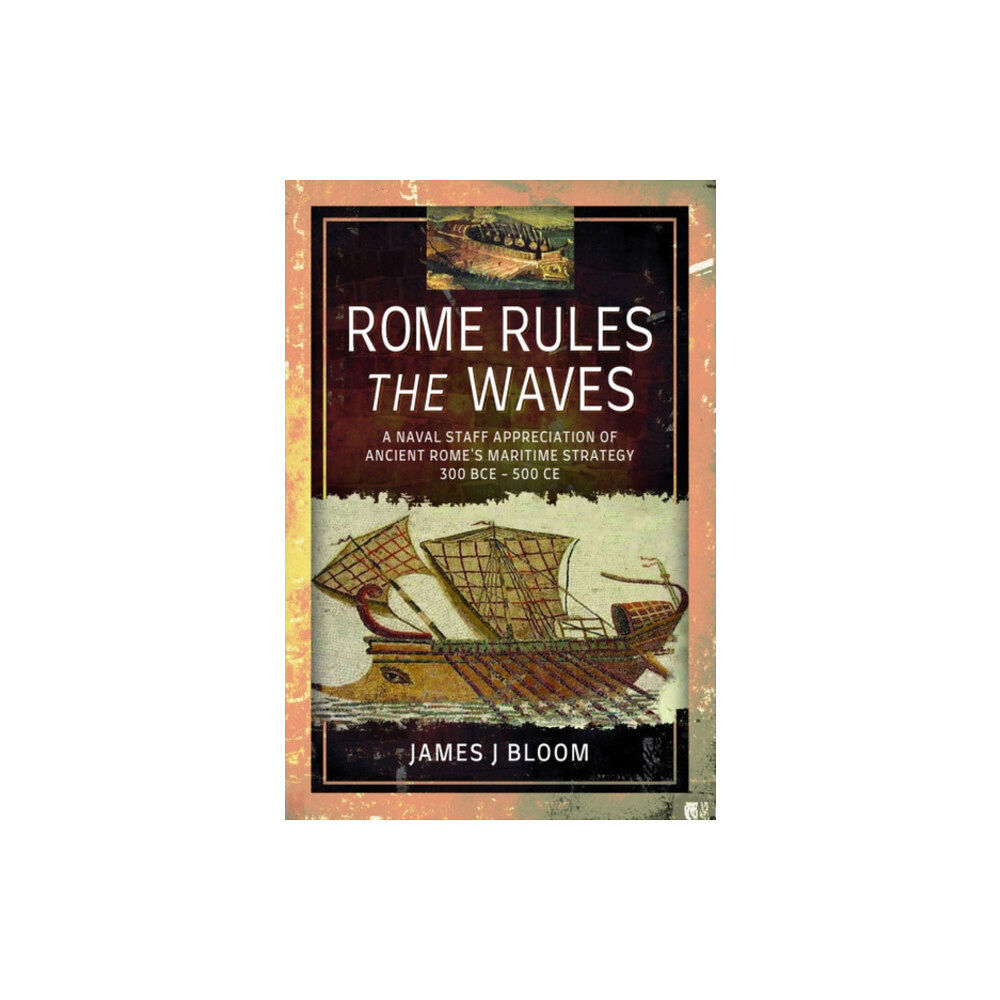- Hem
- Böcker
- Kurslitteratur
- Historia
- Rome Rules the Waves (inbunden, eng)

Rome Rules the Waves (inbunden, eng)
The commonly-held view of Rome's naval history is that it essentially ended with the defeat of Antony and Cleopatra's fleet at Actium in 31...
295 kr
329 kr
Bara 2 kvar
Skickas inom 4 - 5 vardagar
Fri frakt över 399:-
Snabb leverans
Alltid låga priser
Produktbeskrivning
The commonly-held view of Rome's naval history is that it essentially ended with the defeat of Antony and Cleopatra's fleet at Actium in 31 BC, which left Rome with no rivals at sea just as the Republican period gave to the Empire. There were no more big naval battles so, this view would have it, Rome's navy was scarcely needed and its role was of little significance to the strategy of the Empire.
James J Bloom rams this point of view below the waterline in his reappraisal of the crucial role of the Roman imperial navy. The author (following the line of preeminent naval theoreticians, Alfred Mahan and Sir Julian Corbett) takes the view that sea power is not merely about naval engagements.
In its deeper sense, sea power is the steadfast exertion of command of the sea lanes to project trade, suppress piracy, transport troops and supplies and protect land-based military garrisons and expeditions. In effect, this book is a grand-strategical survey of Roman naval power as an instrument to support Roman imperial policy.
In contrast to other works on the subject, Bloom argues that modern naval strategic theory can be usefully applied to Roman naval operations.The geography of their empire determined that the Romans would move most of their military supplies by water. During both the Republican and Imperial periods, nearly all of the provinces had extensive coasts alongside the Mediterranean, the Black Sea or the Atlantic Ocean.
These interconnected seaways gave the Romans a distinct advantage over their adversaries around the perimeter, who generally had to utilize coasts adjacent to or interdicted by Roman maritime control. As Roman land power threaded along the Black Sea and Atlantic shorelines, major river and estuarine systems became a significant component of this web of vital waterways.
Amphibious reach was an essential element of Roman sea power in guarding the wet flanks of the legions and ferrying troops to threatened choke points. Appendices will include scale drawings of the various ship types discussed in the text with their characteristics displayed in tabular form, several maps illustrating the maritime factors of the empire, and a resume of maritime exploration and discoveries in Roman times.
James J Bloom rams this point of view below the waterline in his reappraisal of the crucial role of the Roman imperial navy. The author (following the line of preeminent naval theoreticians, Alfred Mahan and Sir Julian Corbett) takes the view that sea power is not merely about naval engagements.
In its deeper sense, sea power is the steadfast exertion of command of the sea lanes to project trade, suppress piracy, transport troops and supplies and protect land-based military garrisons and expeditions. In effect, this book is a grand-strategical survey of Roman naval power as an instrument to support Roman imperial policy.
In contrast to other works on the subject, Bloom argues that modern naval strategic theory can be usefully applied to Roman naval operations.The geography of their empire determined that the Romans would move most of their military supplies by water. During both the Republican and Imperial periods, nearly all of the provinces had extensive coasts alongside the Mediterranean, the Black Sea or the Atlantic Ocean.
These interconnected seaways gave the Romans a distinct advantage over their adversaries around the perimeter, who generally had to utilize coasts adjacent to or interdicted by Roman maritime control. As Roman land power threaded along the Black Sea and Atlantic shorelines, major river and estuarine systems became a significant component of this web of vital waterways.
Amphibious reach was an essential element of Roman sea power in guarding the wet flanks of the legions and ferrying troops to threatened choke points. Appendices will include scale drawings of the various ship types discussed in the text with their characteristics displayed in tabular form, several maps illustrating the maritime factors of the empire, and a resume of maritime exploration and discoveries in Roman times.
| Format | Inbunden |
| Omfång | 288 sidor |
| Språk | Engelska |
| Förlag | Pen & Sword Books Ltd |
| Utgivningsdatum | 2019-12-06 |
| ISBN | 9781781590249 |
Specifikation
Böcker
- Format Inbunden
- Antal sidor 288
- Språk Engelska
- Utgivningsdatum 2019-12-06
- ISBN 9781781590249
- Förlag Pen & Sword Books Ltd
Leverans
Vi erbjuder flera smidiga leveransalternativ beroende på ditt postnummer, såsom Budbee Box, Early Bird, Instabox och DB Schenker. Vid köp över 399 kr är leveransen kostnadsfri, annars tillkommer en fraktavgift från 39 kr. Välj det alternativ som passar dig bäst för en bekväm leverans.
Betalning
Du kan betala tryggt och enkelt via Avarda med flera alternativ: Swish för snabb betalning, kortbetalning med VISA eller MasterCard, faktura med 30 dagars betalningstid, eller konto för flexibel delbetalning.
Specifikation
Böcker
- Format Inbunden
- Antal sidor 288
- Språk Engelska
- Utgivningsdatum 2019-12-06
- ISBN 9781781590249
- Förlag Pen & Sword Books Ltd
